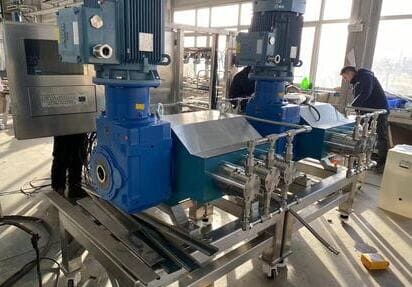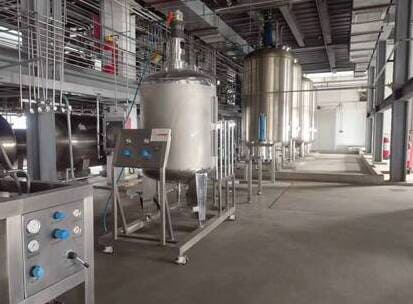A Process Guaranteed Solution for 97%+ Content & Purity
In today’s world, where health and wellness are at the forefront of many people’s minds, Omega-3 polyunsaturated fatty acids (PUFA) have taken center stage.
Marine fish oil and some natural algae are the source of these vital nutritional ingredients, which have been demonstrated to be effective and have valued health benefits.
However, not all Omega-3 products are created equal content, with purity levels varying wildly. This article presents a complete process guaranteed solution for purifying Omega-3 fatty acids to achieve a concentration above 97%, ensuring a high purity product for consumers.
The Importance of the Purification Process for Omega-3 Fractions
Purification is integral to producing high-quality omega-3 supplements from fish oil concentrates. Omega-3 PUFA, derived from deep-sea fish species, has numerous health benefits, including supporting heart health and reducing inflammation. However, fish oil concentrates can contain impurities like heavy metals, dioxins, PCBs, furanspersistent organic pollutants (POPs), and other contaminants that pose significant health risks to human’s body.
To address these concerns, manufacturers rely on refinement and concentration processes such as esterification, enzymatic, bleaching, thin-film evaporation, molecular distillation etc. These processes allow for the enriching of Omega-3 PUFA but are limited to up to 60%-70% concentration.
Ensuring the safety and efficacy of omega-3 supplements is paramount. According to the World Health Organization, “Quality control and purity of fish oil concentrates is a critical issue that needs to be addressed to minimize the risk of adverse effects to health” (World Health Organization). Manufacturers can produce nutritional ingredients that meet the highest safety and quality standards by removing impurities.
High-Performance Liquid Chromatography (HPLC) Separation System is used to Produce Highly Concentrated Omega-3 FA of at least 97wt-%

The complete purification system is a purpose-built Preparative High-Pressure Liquid Chromatography for natural extract purification that uses simulated moving bed (SMB) technology on multi-stage columns.
First, the system continuously pumps the sample through the column in semi-automatic or full-automatic mode. Then, a specialized high-pressure column separates the components based on their chemical properties and interactions, yielding a final product with at least 97% of the desired element, such as EPA (Eicosapentaenoic Acid) or DHA (Docosahexaenoic Acid) monomers.
HPLC offers high accuracy and precision, helping the final product meet strict quality standards in the pharmaceutical industry. It’s also scalable, producing small or large quantities of highly concentrated Omega-3 products, making it ideal for various applications.
We pride ourselves on delivering high-quality, innovative solutions tailored to meet the specific process requirements of our customers.
While working with an experienced team of experts dedicated to providing exceptional service and ensuring your satisfaction at every step of the way. We understand that each organization has unique needs, and we would be more than happy to discuss how our solutions can be customized to meet your specific requirements. Please feel free to schedule a meeting with our team, and we can explore the possibilities further.
Basic Steps to Achieve High-purity EPA or DHA Monomers Using HPLC Columns
Step 1: Feed Material Preparation
Before beginning the purification process, it is crucial to prepare the material with as higher content as possible. Pre-refined and concentrated feed material will save the cost of investment significantly on the purification system. This can be done by subjecting the sample to filtration, bleaching, transesterification, adsorption, deodorization, crystallization, centrifugation, concentration process, etc.
Step 2: Solvent Selection
The next step is to select the appropriate solvent for the separation process. A commonly used solvent for HPLC is methanol, which is mixed with water to form a mobile phase. The proportion of methanol to water must be carefully selected to ensure optimal separation of the EPA or DHA monomers.
Step 3: Column Selection
The design and selection of a column are crucial in achieving high purity of EPA or DHA monomers. The Multi-column rolling cycle purification process is used as it provides highly efficient separation of these monomers from other components in the sample.
Step 4: Mobile Phase Optimization
The mobile phase flow rate, column temperature, and pressure must be carefully optimized to ensure efficient separation of the EPA or DHA monomers. This is done by adjusting the parameters in the lab. Scale testing and verification of the process until the desired resolution between the components is achieved.
Step 5: Collection and Analysis
Once the separation process is complete, the purified EPA or DHA monomers are collected and analyzed to determine their purity. The analysis is usually performed using a Agilent HPLC, UV-Vis spectrophotometer, which measures the absorbance of the sample at specific wavelengths. An incubator for microorganisms, etc.

We are providing a complete purification process developing solution for obtaining high-purity EPA or DHA monomers using HPLC columns. Following the implementation of URS documents, process R&D process, DDS/DQ, equipment fabrication and delivery, FAT at the factory and on-site.
We shall not only support your installation and commissioning at the job site, but also offer hands-on experience in maintenance and replacement at the workplace.
The Goal of the Purification Process is for Content & Purity
Purifying fish oil concentrates to produce high-quality omega-3 supplements is the goal of the purification process. This process aims to enhance the content of effective ingredients and minimize impurities, resulting in a safe and effective product for consumers.
The purification process addresses two main issues. Firstly, it improves the content of EPA in fish oil concentrates. The separation and purification process through an HPLC system can raise the content of EPA-EE to 98.5%, 99%, or even 99.5%.
This not only enhances the market value of the EPA but also makes the investment in purification equipment more profitable. Similar to DHA and other pharmaceutical active ingredients.
Secondly, the purification process eliminates impurities like heavy metals and persistent organic pollutants (POPs) that harm human health. The process can be adjusted to control contaminants to a maximum of 0.3%, 0.2%, or even 0.1%, depending on the requirement, to ensure the safety and quality of the end product.
Consumers should be mindful of the purification process used when choosing omega-3 supplements. The National Institutes of Health recommends selecting products that have undergone purification processes and are certified by third-party organizations.
Why High-Purity Fish Oil is Worth the Investment
Omega-3 fish oil fractions are a crucial component of a healthy diet, but not all fish oil supplements are created equal.
When shopping for fish oil supplements, consumers are faced with a choice between low-purity and high-purity options. The price difference is primarily due to the purity and content of Omega-3 ingredients, with high-purity options typically costing more.
But, a study from Wageningen University in the Netherlands published in the New England Journal of Medicine suggests that high-purity fish oil is worth the investment.
The study found that low-purity fish oils are ineffective in preventing cardiovascular disease, while high-purity options have been shown to reduce triglycerides without raising cholesterol levels, acting as a “scavenger” in the blood vessels. These findings make a strong case for investing in high-purity fish oil supplements.
Our HPLC separation system is a cost-effective solution to create highly concentrated Omega-3 products with a purity of at least 97%.
The system separates the products and ensures their high purity. For example, in the current project of producing high-purity Omega-3 PUFA in China, which is utilizing the HPLC systems to produce an EPA-EE monomer with a purity of 97%+ with a cost of about $82 per kilogram. This cost is approximately one-third of traditional high-pressure preparative chromatography production in other production lines. The added market value from increased content and purity of Omega-3 ingredients is far beyond the investment prospect.
If you have any question about the purification process for fish oil Omega-3 fractions, welcome to contact and discuss with us.

